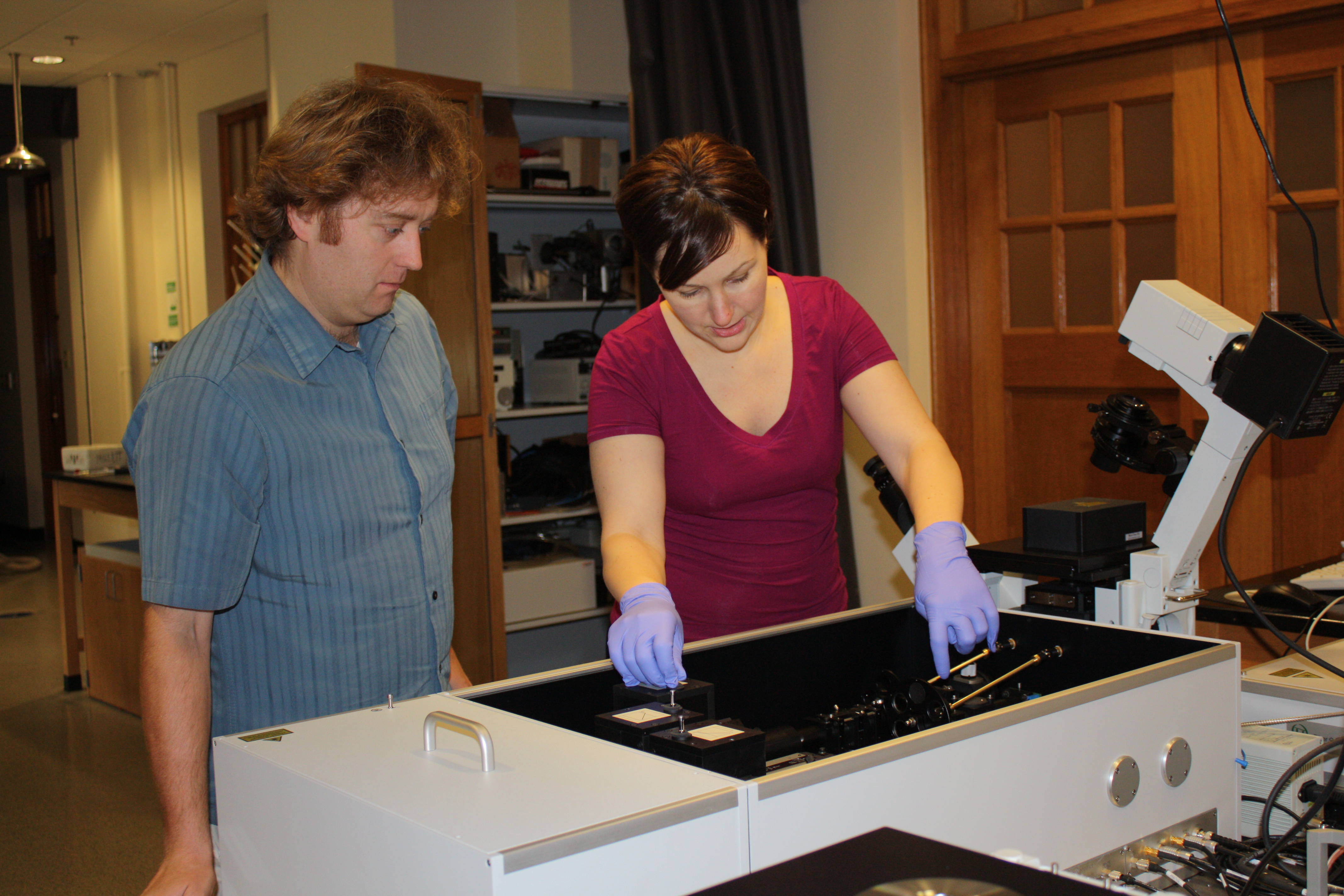Chemist Receives National Science Foundation Early Career Award

Colin Heyes, left, and research collaborator Nela Durisic align the optical components of a microscope to improve its sensitivity to detect single quantum dots.
FAYETTEVILLE, Ark. – Colin Heyes, an assistant professor in the department of chemistry and biochemistry in the J. William Fulbright College of Arts & Sciences at the University of Arkansas, has received a $650,000 Faculty Early Career Development Program award from the National Science Foundation. The award was given to further his investigation of the interfaces between the core and shell of colloidal quantum dots.
Colloidal quantum dots are microscopic semiconductor crystals that are grown in solution. Adding a shell to the core quantum dot provides a way to control the functionality of these crystals, which can be used to emit light for biomedical imaging, LEDs and spectroscopy or photocurrents for solar cells and chemical sensors. The research will help scientists better understand the relationship between the structure of the quantum dot and its functionality.
“All of these modern applications rely on the same fundamental electronic processes within quantum dots,” Heyes said. “Our work will provide a better understanding of how to control these crystals to eventually build brighter, faster, longer-lasting and more efficient products.”
Heyes studies the interfacial chemistry between the core, shell and ligands of colloidal quantum dots. Ligands sit on the shell surface and “hold” the colloidal quantum dots in solution; they also provide a chemical connection to the “outside world” so that quantum dots can attach to biological cells, solar cells or act as chemical sensors.
 There is a lack of fundamental understanding about the structural properties of the core-shell and shell-ligand interfaces. Scientists can observe the boundary between the core and shell materials using powerful electron microscopes, but they do not yet understand how the nature of the structural mismatches between the two materials affects their optical and electrical properties. These mismatches create “holes” or “trap states” that result in losing control of excitons, which are electrons that have been energetically excited. The inability to control excitons result in energy lost as heat rather than converted into useful energy, such as light or electrical currents.
There is a lack of fundamental understanding about the structural properties of the core-shell and shell-ligand interfaces. Scientists can observe the boundary between the core and shell materials using powerful electron microscopes, but they do not yet understand how the nature of the structural mismatches between the two materials affects their optical and electrical properties. These mismatches create “holes” or “trap states” that result in losing control of excitons, which are electrons that have been energetically excited. The inability to control excitons result in energy lost as heat rather than converted into useful energy, such as light or electrical currents.
The NSF grant will expand Heyes’ investigation of how the optical and electrical properties of quantum dots are related to the core-shell and shell-ligand interfaces at the single quantum dot level. Understanding single quantum dots is necessary to advance miniaturized optoelectronics and single molecule fluorescence applications. His research team has produced preliminary data demonstrating that as these interfaces are systematically varied, the optical properties of single quantum dots can be tuned.
“We hypothesize that understanding the relationship between the structures of the core-shell or shell-ligand interfaces and the trap states will allow us to more precisely control these excitons that underlie the optical and electrical properties,” Heyes said.
Heyes’ team will focus specifically on understanding how the trap states are formed and how they contribute to the optical and electronic properties with the eventual goal of avoiding their formation altogether.
The grant will support Heyes’ research in this area for the next five years and will encourage and promote the participation of graduate, undergraduate and minority students. As part of the grant, a two-week, hands-on workshop will be held each summer on the U of A campus. Undergraduate students from the university and from undergraduate institutions in Arkansas and Oklahoma will perform research experiments in Heyes’ lab to promote and foster their interest in chemistry and nanomaterial science for eventual careers in the fields of science, technology, engineering and math.
Contacts
Colin Heyes, assistant professor, chemistry and biochemistry
J. William Fulbright College of Arts & Sciences
479-575-5607,
cheyes@uark.edu
Matt McGowan, science and research communications officer
University Relations
479-575-4246,
dmcgowa@uark.edu
Headlines
PetSmart CEO J.K. Symancyk to Speak at Walton College Commencement
J.K. Symancyk is an alumnus of the Sam M. Walton College of Business and serves on the Dean’s Executive Advisory Board.
Faulkner Center, Arkansas PBS Partner to Screen Documentary 'Gospel'
The Faulkner Performing Arts Center will host a screening of Gospel, a documentary exploring the origin of Black spirituality through sermon and song, in partnership with Arkansas PBS at 7:30 p.m. Thursday, May 2.
UAPD Officers Mills and Edwards Honored With New Roles
Veterans of the U of A Police Department, Matt Mills has been promoted to assistant chief, and Crandall Edwards has been promoted to administrative captain.
Community Design Center's Greenway Urbanism Project Wins LIV Hospitality Design Award
"Greenway Urbanism" is one of six urban strategies proposed under the Framework Plan for Cherokee Village, a project that received funding through an Our Town grant from the National Endowment for the Arts.
Spring Bike Drive Refurbishes Old Bikes for New Students
All donated bikes will be given to Pedal It Forward, a local nonprofit that will refurbish your bike and return it to the U of A campus to be gifted to a student in need. Hundreds of students have already benefited.




